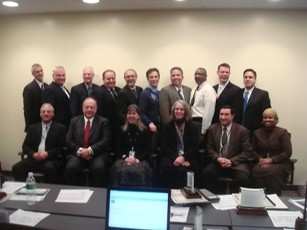Sat, Jan 23, 2010
Meeting To Review Changes In Hudson River Airspace Adopted
Following August Mid-Air
Helicopter Association International (HAI) President Matt
Zuccaro attended a meeting of the FAA New York VFR Airspace Task
Force, of which he is a member, Wednesday and Thursday of last
week. The meeting took place at the Federal Building in lower
Manhattan, New York City.

VFR Airspace Task Force
The Task force was established
following the August 2009 midair collision between an airplane and
helicopter within the Class B airspace exclusion over the Hudson
River in New York City. The task force, led by Gary Norek, FAA
Terminal Airspace Manager, developed recommendations to improve
safety within the Class B excluded airspace in the New York City
area which included:
- Modification of the overlying Class B airspace to allow
stratification of transient and local operations within the Class B
excluded airspace
- Establishment of mandatory reporting points for aircraft within
the exclusion
- Making previously recommended operating procedures
mandatory
- Development of an FAA/industry training program for pilots, ATC
controllers, and Heliport FBOs
- Revised ATC procedures for fixed-wing operations from Teterboro
airport
- Reviewed airspace delegation between New York Tracon and local
ATC towers
- Establishment of a VFR Class B airspace transition route above
the Hudson River
- Standardization of various New York area aeronautical
charts
- Enhancement of pilot communications capabilities and to reduce
frequency congestion on Hudson River Common Traffic Advisory
Frequency (CTAF)
The above-noted recommendations were
adopted by the FAA and enacted this past November.
This meeting allowed for a review of operations within the New York
Class B airspace exclusion since the task force recommendations
were enacted in November, and an opportunity to identify any
additional areas of improvement.

Mike McCormick, Matt Zuccaro
During the meeting, the members of the
Task Force, which include FAA staff; industry representatives such
as HAI, the Eastern Region Helicopter Council, and the Aircraft
Owners and Pilots Association; air traffic controllers; and the New
York Port Authority, were awarded Certificates of Appreciation from
the FAA in acknowledgement of their work.
More News
Light Gun A handheld directional light signaling device which emits a brilliant narrow beam of white, green, or red light as selected by the tower controller. The color and type of>[...]
"The journey to this achievement started nearly a decade ago when a freshly commissioned Gentry, driven by a fascination with new technologies and a desire to contribute significan>[...]
Aero Linx: JAARS, Inc. For decades now, we’ve landed planes on narrow rivers and towering mountains. We’ve outfitted boats and vehicles to reach villages that rarely se>[...]
"Our driven and innovative team of military and civilian Airmen delivers combat power daily, ensuring our nation is ready today and tomorrow." Source: General Duke Richardson, AFMC>[...]
Aircraft Conflict Predicted conflict, within EDST of two aircraft, or between aircraft and airspace. A Red alert is used for conflicts when the predicted minimum separation is 5 na>[...]
 ANN's Daily Aero-Term (04.20.24): Light Gun
ANN's Daily Aero-Term (04.20.24): Light Gun Aero-News: Quote of the Day (04.20.24)
Aero-News: Quote of the Day (04.20.24) ANN's Daily Aero-Linx (04.21.24)
ANN's Daily Aero-Linx (04.21.24) Aero-News: Quote of the Day (04.21.24)
Aero-News: Quote of the Day (04.21.24) ANN's Daily Aero-Term (04.21.24): Aircraft Conflict
ANN's Daily Aero-Term (04.21.24): Aircraft Conflict




